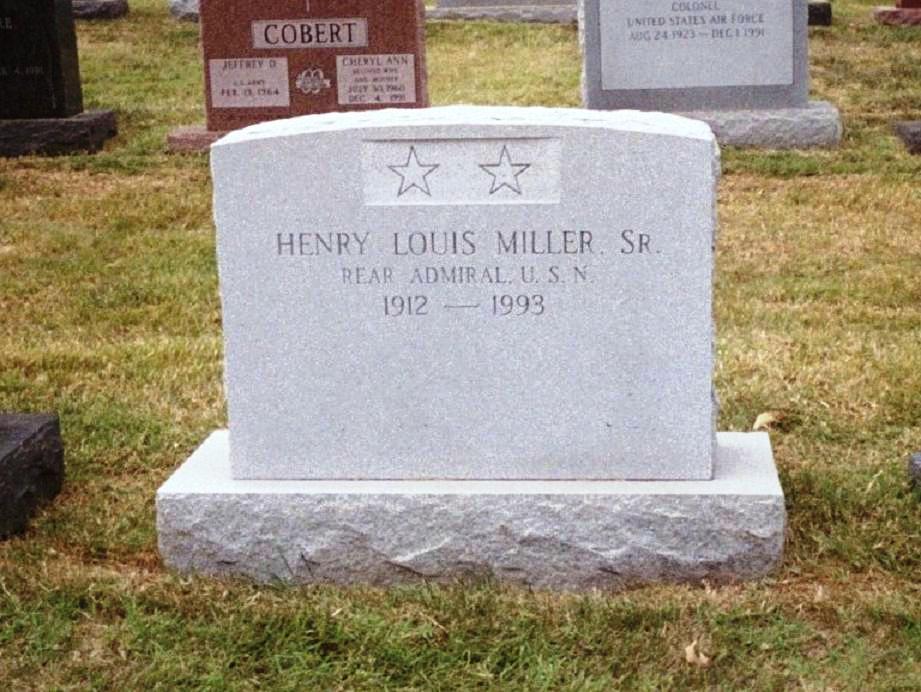Henry L. Miller, Rear Admiral, United States Navy.
Born on July 18, 1912 at Fairbanks, Alaska.
Graduated from the United States Naval Academy June 1934.
Prior to World War II served three years aboard on the U.S.S. Texas and the U.S.S. Saratoga.
After his return from duty aboard the U.S.S. Hornet with Doolittle’s Tokyo Raiders, he commanded Air Group 23, based on the U.S.S. Princeton. He commanded Air Group 6 for remainder of the war, based on the U.S.S. Hancock.
Subsequently served with the Office of Naval Research, Atlantic and Pacific Fleets and Office of the Chief of Naval Operations.
He was a graduate of the Industrial College of the Armed Forces. He was made an Honorary Tokyo Raider for his part in training their personnel at Eglin Field, Florida, and later at a California base before boarding the U.S.S. Hornet. He was promoted to Rear Admiral July 1959.
His personal decorations included the Distinguished Flying Cross with 4 Gold Stars, Air Medal with 5 Gold Stars, Legion of Merit with 3 Gold Stars and Army Commendation Ribbon. Retired September 1, 1971. Died January 25, 1993.
Courtesy of the United States Navy:
Henry Louis Miller was born on July 18, 1912 in Fairbanks, Alaska. He attended Drews Preparatory School in San Francisco and graduated in 1934. He was designated as the Naval aviator at the Naval Air Station, Pensacola, in June 1938. He then completed the Bombardiers’ course at Sandia Base and the All Weather Flight Course at Corpus Christi Texas.
Miller’s service included three years’ of duty in engineering and gunnery on board the battleship USS Texas (BB-35) and the aircraft carrier USS Saratoga (CV-3). During World War II he trained General Jimmy Doolittle’s “Tokyo Raiders” in carrier take-offs and later accompanied them to within 700 miles of their destination on board USS Hornet in April 1942. From November 1940 to November 1942 he was a Flight Instructor and Personnel Officer at the Naval Air Station, Ellyson Field, Florida. From November 1942 to May 1944 Miller commanded an Air Group based on board USS Princeton (CVL-23), and during the remainder of the war he had command of Air Group SIX stationed on board USS Hancock (CV-19).
He had duty in the Navy Department during the period of December 1945 until July 1948, first assigned to writing Air Operations Instructions, later serving as Executive Officer, Air Branch, Office of Naval Research. For two years he served as Public Information Officer on the Staff of Commander in Chief, Atlantic Fleet, and from June 1950 to August 1952 served successively as Executive Officer of Composite Squadron SEVEN, and of USS Leyte (CV-32).
Miller graduated from Industrial College of the Armed Forces in 1953 and, he reported for duty in the Strategic Plans Division at the Office of the Chief of Naval Operation. Two years later, on August 1955 he assumed command of the U.S. Naval Station, Sangley Point, Luzon, P.I., and on September 1 he became Commander Fleet Air, Philippines, and Commander Naval Air Bases, Philippines. Following his turn at these three positions, he became Assistant Director, later Director of the Progress of the Chief of Naval Operations. And In January 1959 he assumed command of USS Hancock.
Miller received many awards for his services. For his World War II services he was awarded The Legion of Merit with Combat “V”, the Air Medal with five Gold Stars, the Distinguished Flying Cross with Four Gold Stars in lieu of additional awards, the Army Commendation Ribbon, and the Navy Unite Commendation Ribbon.
On July 22, 1959 Miller was commissioned a Rear Admiral, and was appointed Chief of Staff and Aide to the Commander Naval Air Force, Pacific. Rear Admiral Henry Louis Miller commanded Carrier Division FIFTEEN, which is the Anti-Submarine Hunter-Killer Task Group from May 1961 to June 1962. Admiral Miller also served as Assistant Chief of Staff for Plans, Joint Staff, Commander in Chief, Pacific, during the time when the turmoil in South East Asia escalated. He then assumed command of Carrier Division THREE, a Heavy Attack Carrier Task Group, and at the same time he took command of Task Force, SEVENTY-SEVEN, and the Carrier Striking Force of the SEVENTH FLEET.
The admiral also served in Vietnam and launched the first of a succession of aircraft carrier strikes on North Vietnam from the decks of USS Ranger (CV-61), Coral Sea (CV-43) and Hancock. In October of 1965, he took the nuclear powered Task Group, USS Enterprise (CVN-65) and USS Bainbridge (DLGN-25) from Norfolk, Virginia to Subic Bay, P.I., subsequently on December 2, 1965 he engaged the first nuclear power Task Force in combat with the enemy in Vietnam.
On April 13, 1966 he became Chief of Information, Navy Department and “for exceptionally meritorious conduct…” in the capacity was awarded a Gold Star in lieu of the Third Legion of Merit. In October 1968 he reported as Commander Naval Air Test Center, Patuxent River, Maryland, with additional duty as Command Test and Evaluation Coordinator. He served until relieved of active duty pending his retirement, effective September 1, 1971.
Michael Robert Patterson was born in Arlington and is the son of a former officer of the US Army. So it was no wonder that sooner or later his interests drew him to American history and especially to American military history. Many of his articles can be found on renowned portals like the New York Times, Washingtonpost or Wikipedia.
Reviewed by: Michael Howard

